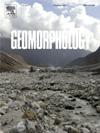Annual surface elevation changes of rock glaciers and their geomorphological significance: Examples from the Swiss Alps
IF 3.1
2区 地球科学
Q2 GEOGRAPHY, PHYSICAL
引用次数: 0
Abstract
Due to the ongoing degradation of permafrost and the associated impacts on the stability of periglacial mountain slopes, there is a need to improve our understanding of the dynamics of rock glaciers over relatively short timescales. There is also a growing interest in the hydrological role of rock glaciers and other ice-debris landforms, as they can potentially store valuable amounts of ice. Despite the acceleration in rock glacier velocities observed primarily in the European Alps, annual and inter-annual changes in surface elevation and volume have so far escaped detailed quantification in monitoring programs. In this study, annual and biannual uncrewed aerial vehicle (UAV) surveys combined with structure-from-motion (SfM) photogrammetric techniques are used to derive high-resolution surface kinematics, elevation and volume changes of three rock glaciers in the Western Swiss Alps. Between 2016 and 2021, detailed digital elevation model (DEM) differencing revealed a high variability of mean annual elevation changes, reaching up to −0.19 ± 0.02 m/yr (2020−2021) at the Yettes Condjà B rock glacier, while elevation changes at the Les Cliosses rock glacier ranged from −0.05 ± 0.02 m/yr (2016–2017) to +0.014 ± 0.008 m/yr (2021−2021). In addition, the multi-temporal and very high-resolution topographic datasets revealed the presence of distinct rock glacier features, including superimposed lobes, lateral levees and flow divides, that could not be identified previously with traditional in-situ measurements and observations. Our results in terms of elevation and surface velocity changes highlight the importance of detailed and regular high-resolution monitoring for understanding the rapid evolution of active glaciers under the current degradation of mountain permafrost.
岩石冰川的年表面高程变化及其地貌意义:瑞士阿尔卑斯山的实例
由于永久冻土的持续退化以及对冰川山坡稳定性的相关影响,我们需要进一步了解岩冰川在相对较短时间内的动态变化。人们对岩冰川和其他冰屑地貌的水文作用也越来越感兴趣,因为它们有可能储存大量宝贵的冰。尽管主要在欧洲阿尔卑斯山观察到岩石冰川速度加快,但迄今为止,冰川表面海拔高度和体积的年度和年际变化还没有在监测项目中得到详细量化。在这项研究中,每年和每半年进行的无人驾驶飞行器(UAV)勘测结合运动结构(SfM)摄影测量技术,得出了瑞士西部阿尔卑斯山三条岩石冰川的高分辨率表面运动学、海拔和体积变化。2016 年至 2021 年期间,详细的数字高程模型(DEM)差分显示,Yettes Condjà B 岩石冰川的年平均高程变化差异很大,最高达 -0.19 ± 0.02 米/年(2020-2021 年),而 Les Cliosses 岩石冰川的高程变化范围为 -0.05 ± 0.02 米/年(2016-2017 年)至 +0.014 ± 0.008 米/年(2021-2021 年)。此外,多时段和高分辨率地形数据集还揭示了岩石冰川的明显特征,包括叠加裂片、侧堤和流向分界线,这些特征是以前传统的现场测量和观测无法识别的。我们在海拔高度和地表速度变化方面的研究结果突出表明,详细和定期的高分辨率监测对于了解当前山区永冻土退化情况下活动冰川的快速演变非常重要。
本文章由计算机程序翻译,如有差异,请以英文原文为准。
求助全文
约1分钟内获得全文
求助全文
来源期刊

Geomorphology
地学-地球科学综合
CiteScore
8.00
自引率
10.30%
发文量
309
审稿时长
3.4 months
期刊介绍:
Our journal''s scope includes geomorphic themes of: tectonics and regional structure; glacial processes and landforms; fluvial sequences, Quaternary environmental change and dating; fluvial processes and landforms; mass movement, slopes and periglacial processes; hillslopes and soil erosion; weathering, karst and soils; aeolian processes and landforms, coastal dunes and arid environments; coastal and marine processes, estuaries and lakes; modelling, theoretical and quantitative geomorphology; DEM, GIS and remote sensing methods and applications; hazards, applied and planetary geomorphology; and volcanics.
 求助内容:
求助内容: 应助结果提醒方式:
应助结果提醒方式:


